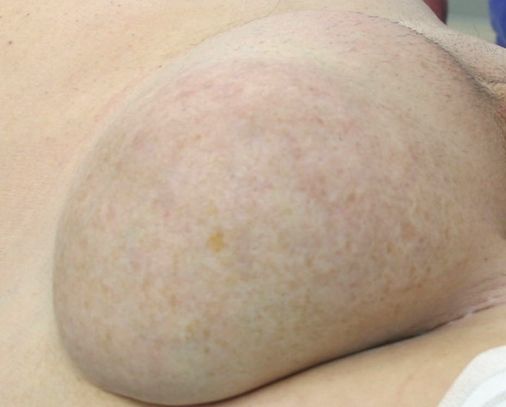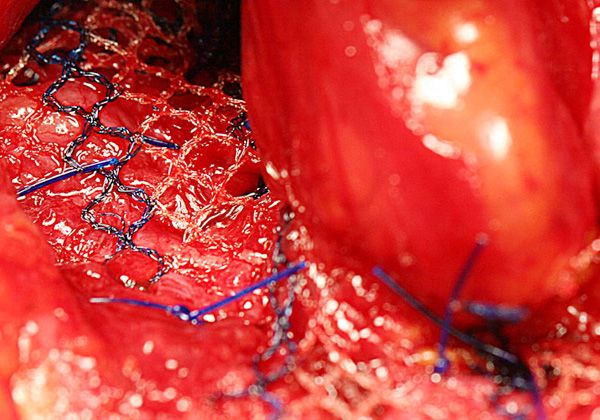Inguinal hernia is the most common form of hernia. Here you will find qualified hernia surgeons for the treatment of inguinal hernias. All listed physicians are specialists in their field and have been carefully selected for you according to strict guidelines.
Recommended specialists
Article overview
Inguinal hernia is the most common form of hernia. An inguinal hernia, also referred to as groin hernia, is a visceral or bowel hernia in the region of the inguinal canal, in which a gap forms in the abdominal wall in the inguinal or groin region, through which bowel parts, which are still enclosed by the peritoneum, protrude outward from the abdominal cavity. The gap that has been formed in an inguinal hernia is also referred to as hernial orifice. The peritoneum, which, along with the bowel parts contained in it, protrudes outward through the hernial orifice in the abdominal wall like a pouch, forms the so-called hernial sac. The protruded bowel parts enclosed in the peritoneum, including for instance parts of the intestine, constitute the so-called hernial contents.

Inguinal hernia in a male patient © Prof. Dr. med. Thomas W. Kraus
Every year, around 0.5 percent of the population suffer a visceral hernia in the region of the inguinal canal. Hence, inguinal hernia is one of the most common surgical diseases in humans. Moreover, inguinal hernia constitutes the most common form of hernia, accounting for 75 to 80 percent of all visceral hernias, with men being considerably more frequently affected than women, around 80 percent of all inguinal hernias occurring in men.
Forms of inguinal hernia
Basically, congenital and acquired inguinal hernias can be distinguished, as can direct and indirect inguinal hernias. The distinction between a direct and an indirect inguinal hernia depends on where the hernial orifice is located and in which direction the hernial sac protrudes through the hernial orifice in the inguinal or groin region. A direct inguinal hernia, also referred to as medial inguinal hernia, is normally acquired and occurs primarily in elderly men. In this form of hernia, the hernial sac protrudes directly and vertically outward from the abdominal cavity through the hernial orifice at the rear wall of the inguinal canal.
An indirect inguinal hernia, also referred to as lateral inguinal hernia, is in most cases congenital. In this form of inguinal hernia, which accounts for around two thirds of all inguinal hernias, the hernial sac protrudes through the internal orifice of the inguinal canal into the inguinal canal along the spermatic cord (in men), or the round ligament of the uterus (in women).
Causes and risk factors for inguinal hernia
Inguinal hernias develop due to a weak spot in the abdominal wall in the region of the inguinal canal. Different causes are possible, depending on whether the inguinal hernia is a congenital or an acquired one. In a congenital inguinal hernia, the weak spot causing the hernia is due to incomplete internal closure of the abdominal wall during early childhood. The weak spot underlying an acquired inguinal hernia can, among other causes, be due to abdominal surgery and congenital weakness of the connective tissue. The triggering events and risk factors which may then cause an acquired inguinal hernia include, among others, chronically increased pressure in the abdominal cavity, for instance when lifting heavy loads, when coughing or when vomiting, as well as due to pregnancy or overweight.
Symptoms of inguinal hernia
An inguinal hernia typically manifests itself in the form of a visible and palpable protrusion in the inguinal or groin region, which can normally be easily pushed back inside and protrudes distinctly particularly in the evening and after physical strain. Besides this, symptoms such as a feeling of pressure and mild dragging pain, which intensify upon increased pressure in the abdomen, for instance when coughing, sneezing, pressing (e.g. when defecating on th toilet), and also upon physical exertion, often occur in the inguinal region in connection with an inguinal hernia. Serious complications can occur in connection with an inguinal hernia if the bowel parts in the hernial sac get incarcerated or stuck in the hernial orifice. In this case, intense pain and sometimes nausea and vomiting occur. In the worst case, there is a risk of bowel occlusion, which may result in bowel rupture and peritonitis.
Diagnosis of inguinal hernia
An inguinal hernia is normally diagnosed in the scope of a case history interview, in which the physician asks the patient targeted questions regarding his symptoms and complaints, and in the scope of a subsequent physical examination in which the physician examines and carefully palpates the patient's inguinal or groin region. In addition, further examinations can be performed for diagnosing an inguinal hernia, such as for instance an ultrasound examination (sonography) or a magnetic resonance tomography (MRT). The purpose of these is to be able to better assess the inguinal hernia and rule out other diseases.
Treatment of inguinal hernia
An inguinal hernia is normally treated operatively in the scope of hernia surgery, since it never regresses spontaneously, but will rather increase in size over time, and since there is a risk of bowel parts being incarcerated or getting stuck. Only in the case of high-risk patients, e.g. patients of very high age or with serious concomitant diseases, will the doctor attempt to monitor the condition conservatively. As for hernia trusses, doctors normally have a low opinion of these.

Inguinal hernia operated with net according to the Lichtenstein method © Prof. Dr. med. Thomas W. Kraus
In the inguinal hernia operation, which can either be performed as minimally invasive surgery, i.e. with endoscopic or laparoscopic procedures, or conventionally in the scope of an open intervention, the hernial contents are first displace back into the abdominal cavity, and the hernial orifice in the abdominal wall is then closed. To close the hernial orifice, either a pure suture procedure in which the inguinal hernia is treated and reinforcement is accomplished with sutures can be used, or, much more commonly, a procedure in which a light synthetic mesh is employed can be used.




























